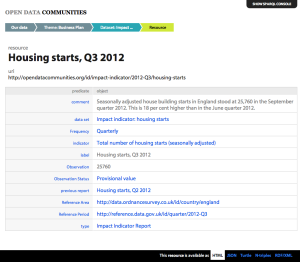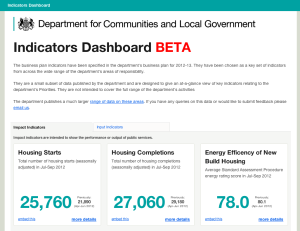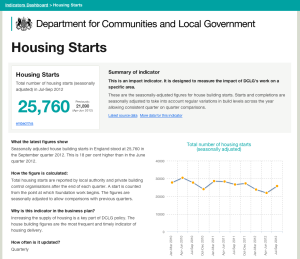If you’ve read my guest blog at the ODI, you’ll have spotted that I’m trying to push forward DCLG’s open data contribution on three main fronts.
One of those is: testing how to grow and extend our open data store to incorporate more DCLG data.
Late last week, we released the first new, and (I think) exciting output: our Business Plan Indicators dashboard., and supporting page about DCLG’s priority actions.
If you’re unfamiliar with Departmental Business Plans, the indicators are designed to help you, the public, assess how we’re doing on our various policies and reforms. Our Business Plan includes further information about each indicator, and how they align with Departmental and the coalition government’s priorities. For ease of ref, I’ve repeated the list below.
Introducing the Business Plan Indicators Dashboard
You’ll see from the opening page that we’ve tried to present the latest headline data in a neat, engaging way. For each indicator, you’ll find a panel showing the latest figure with links to more detailed information.
Clicking on “more detail” provides additional information including: what the latest figures show; how the figure is calculated; and why the indicator is in our business plan. You’ll also find a time series line chart, and a link to embed the summary in your own web page.
Note too that each “more detail” page includes a link to the underlying source datasets. Click on the “latest source” or “more data” links, and you’ll jump across to our open data store, from where you can query, retrieve and re-use data in a range of open formats.
 |
 |
Where next?
I think of the dashboard as the top of DCLG’s data pyramid, beneath which are lots more detailed datasets.
Let’s take the Housing Starts impact indicator as an example. This is calculated from our official statistics on House building. We also routinely publish live-tables containing further detailed statistics; e.g. breaking down the figures by local authority and tenure. The same is true for most other indicators in the Business Plan.
So, we have a great opportunity here to join-up this lovely content. I want to make it possible for you to quickly and easily move up and down the data pyramid, discovering and exploring links within and between the myriad of related datasets at each layer. I also want you (and DCLG itself!) to be able to retrieve it, re-use it, and join it up over the web to related sources that we don’t hold: for example, to link to more detailed data in, say, local authorities on land for housing, completions and so on.
Clearly, this will take time to achieve. As outlined in my ODI blog post, a key first step is to establish our open data store as a permanent, sustainable resource for routinely releasing DCLG statistical outputs in 5-star, accessible formats. We’re on track to appoint a technology partner in February 2013.
As we move forward, I’m keen to work with our data users and third-party software innovators. I want to know that we’re releasing the right data, in the right formats, at the right time. I’d also like to explore and exploit opportunities for joining-up our datasets to external sources, over the web, using open re-usable standards.
Which leaves me with some questions for you:
1. Which DCLG datasets do you want us to release first in 5-star formats? If you’re not sure what we hold, please take a look around data.gov.uk, or search our statistics and our transparency datapublications on gov.uk.
2. How can we help you to find and understand our datasets more quickly and easily? For instance, do you search for data using particular terms? Do you like (and use) visualization tools like the dashboard? Do you have any ideas for new tools and visualisations?
3. Do you use DCLG data alongside other third-party sources? If yes, which sources are you using? How can we make it easier for you to retrieve and combine multiple dataset? And, do you have ideas on how we could do that over the web, using open standards?
DCLG Business Plan priorities and Business Plan indicators
Decentralise power as far as possible
1. Percentage of local authority revenue expenditure funded by general government grant, broken down by class of authority (Input indicator)
2. Percentage of local authorities committed to identifying and beginning work with troubled families (Input indicator)
Reinvigorate local accountability, democracy and participation
3. Number of groups supported to submit an expression of interest as part of the Community Right to Challenge (Impact indicator)
4. Fire-related casualties (per 100,000 population) (Impact indicator)
Support and incentivise local growth
5. Business rates yield within Enterprise Zones (Impact indicator)
Meet people’s housing aspirations
6. Affordable Rent payment per dwelling by the Homes and Communities Agency (Input indicator)
7. Average New Homes Bonus grant payable per dwelling per year to different classes of authority (£) (Input indicator)
8. Total number of housing starts and completions (seasonally adjusted) (Impact indicator)
9. Number of affordable housing starts and completions delivered through the Homes and Communities Agency (Impact indicator)
10. Energy efficiency of new build housing (average Standard Assessment Procedure energy rating score) (Impact indicator)
11. Households in temporary accommodation (seasonally adjusted) (Impact indicator)
Put communities in charge of planning
12. Percentage of local planning authorities having an adopted local plan prepared under the 2004 Planning and Compulsory Purchase Act (Impact indicator)
13. The number of planning permissions granted as a percentage of all applications for major and minor schemes (Impact indicator)


Recent Comments